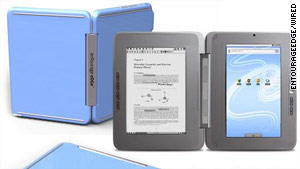The publishing industry has been under a dark cloud recently.
Sales are down this year, despite prominent books by Dan Brown and Edward M. Kennedy. Wal-Mart and Amazon are locked in a war for e-commerce dominance, creating new worries among publishers and authors about dwindling profits.
But amid the gloom, some sellers and owners of electronic reading devices are making the case that people are reading more because of e-books.
Amazon for example, says that people with Kindles now buy 3.1 times as many books as they did before owning the device. That factor is up from 2.7 in December 2008. So a reader who had previously bought eight books from Amazon would now purchase, on average, 24.8 books, a rise from 21.6 books.
“You are going to see very significant industry growth rates as a result of the convenience of this kind of reading,” said Jeffrey P. Bezos, chief executive of Amazon.
Sony, maker of the Reader family of devices, says that its e-book customers, on average, download about eight books a month from its online library. That is far more than the approximately 6.7 books than the average American book buyer purchased for the entire year in 2008, according to Bowker, a publishing industry tracking firm.
The e-reader market also has a new competitor, the Nook, introduced by Barnes & Noble on Tuesday. It will sell for $259.
The book-buying numbers at Amazon and Sony may not by themselves indicate a new interest in reading. Owners of Kindles may be shifting all their book purchases to Amazon. Owners of e-book devices tend to be among the most passionate book buyers, so their behavior may not be reflective of the overall market.
Even so, fans of the reading devices suggest that the convenience of using these products, which offer a sense of control and customization that consumers have come to expect from all their media gadgets, has created a greater interest in books.
Patti Howard is among the converted. “It’s been a long time since I felt this way about books,” said Ms. Howard, a medical transcriptionist from Birmingham, Ala., who for years confined her book reading to 10 minutes before bed until she got an Amazon Kindle in August.
Ms. Howard now buys books any time she wants. She recently downloaded a fantasy novel at 2:30 a.m., immediately after finishing the previous book in a series. She reads during her snippets of daily downtime, like during the wait to pick up her 9-year-old son from school. Her new reading pace is one novel a week.
Other fans praise the benefits of e-book devices. The Kindle and Sony Reader, with their gray-and-white screens and adjustable type sizes, offer a satisfying experience with few of the distractions of other technologies.
Multiple books can also be carried in a slender device, so a reader can easily switch from Kate Morton’s “The Forgotten Garden” to Blake Bailey’s “Cheever: A Life.”
E-books can also be bought quickly and from any location, with one or two clicks on devices like the Kindle and the Nook, which use wireless networks to download books.
Brandon Watson, a researcher at Microsoft and the father of three, says he has gone from reading about a book a month to recently polishing off a book the size of Malcolm Gladwell’s “Outliers” every weekend.
He is taken by the ease of one-handed reading on the Kindle. Last month he bought the digital version of “The Bourne Identity,” even though he had the actual 500-page book in his home, because “for whatever reason, it feels cumbersome to read,” he said.
That point resonates with Candy Yates, a loan officer assistant in Newland, N.C. Ms. Yates owns a computer, a BlackBerry, and an iPod Touch and calls herself a “gadget person.” She says that paper books just feel strange to her, even though she was an avid reader as a child.
The nearest bookstore is also 30 miles away in Boone, and the collection at the local library does not interest her, she said. The Kindle cannot pick up a wireless signal in her home town, but she can plug it into her PC and buy books online.
Such testimonials do not persuade everyone. Many book publishing executives say that e-book sellers like Amazon have a strong interest in heralding a new age of reading, because they must persuade skeptical publishers that a higher sales volume of e-books will offset the eventual loss of profit if the most popular digital editions continue to be sold for $9.99. For now, sellers like Amazon and Barnes & Noble subsidize that price.
Some publishers are also not quite willing to accept the notion that books can make a mainstream resurgence.
“Given the fact that people now have the Internet, almost 24-hour football entertainment in the fall, tennis matches from around the world, TV shows out the wazoo, and movies, do you really believe that people are going to be reading more because they can get it on a screen?” said John Sargent, chief executive of Macmillan, owner of imprints like Farrar, Straus and Giroux and St. Martin’s Press. “I don’t see the scenario.”
The music industry, which stumbled badly during its transition to digital formats, also offers lessons. E-book piracy does not yet constitute a major problem in the United States, but there are warning signs.
Shayna Englin, a political consultant in Washington who purchased a Kindle this year, also says she reads more than ever: a book a week, about three times her old pace.
But she has actually never paid for an e-book. Exploiting a loophole in Amazon’s system, Ms. Englin has linked her Kindle to the Amazon account of some nearby friends, allowing all of them to read books like “The Lost Symbol” at the same time — while paying for them only once.




